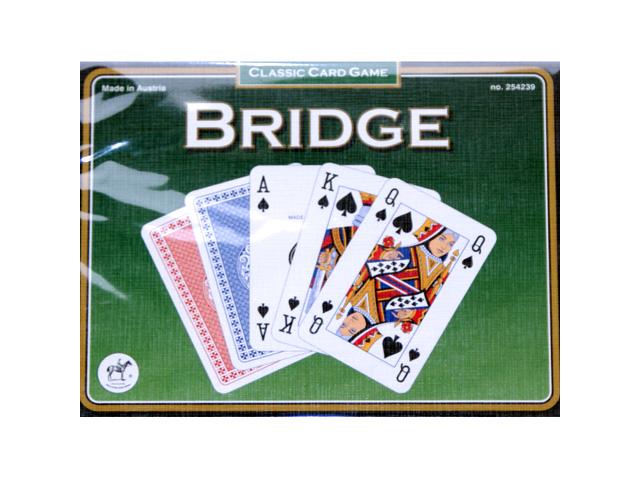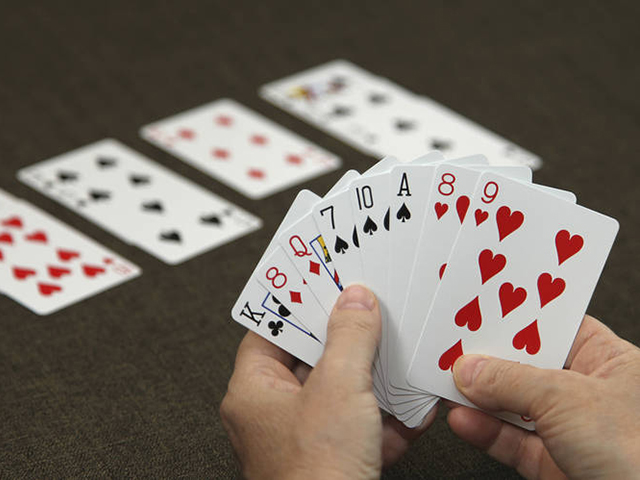Bridge is a card game. Many people have never heard of bridge before, some stubbornly believe that bridge is only played by old English ladies over coffee and cake or by English officers who were bored in India during colonial times.
That’s not true! I don’t belong to either group, yet it’s the most fascinating game I’ve ever known (and I know many). Many other games are in vogue for a while, you play them all night long, and at some point they get dusty in the corner because you know them inside out. I’ve never been bored with bridge, and I’ve been playing it for more than thirty years now.
This page is not a bridge course. I can only give an idea of how bridge works and what its fascination is. If you want to learn it, click on “Learn Bridge” in the control bar on the left to learn more about the possibilities.
Goal of the game
Bridge is played with 52 cards (i.e. a Rommee game without jokers). There are always 4 people playing, the two opposite play all the time together (also called partner). The order of the cards is A, K, D, B, 10, 9, 8, 7, 6, 5, 4, 3, 2. The four colors are called spades, coeurs, diamonds and clubs.
Before the actual game, the so-called stimulation must determine what is the trump card. There is a choice of all four colours, as well as the so-called Sans Atout game (from the French: “without trump”), in which there are no trumps. You also have to tell in advance how many tricks you want to make (together with your partner). The player who dealt the cards starts. If he has good cards, he names a number of tricks (minimum 7, maximum 13) and his preferred trump suit (usually the suit in which he has the most cards). If he has bad cards, he may (or should) pass, of course. Afterwards, the cards are moved in a clockwise direction. Each player can outbid the previous player by either announcing a larger number of tricks or the same number of tricks in a higher suit (the order is from bottom to top: Treff, Karo, Coeur, Pik, Sans Atout). If no one wants to stimulate more, the stimulation is over.
The party that made the last announcement must play. The one of the two who named the trump first becomes the so-called single player. The player sitting to his left plays a card, the partner of the single player lays his cards face up on the table (hence the name dummy or straw man). He does not play any cards himself, but the single player determines which card is added to each trick. Clockwise, each player admits one card (of the same suit, if he has one, otherwise he can discard or stab). Whoever has added the highest card of the suit played (or the highest trump) to a trick wins the trick and plays to the next trick.
When all 13 cards have been played, the game is settled. The single player counts his tricks. If he has as many tricks as he has played (or more, it doesn’t matter how many tricks he has played), his party gets plus points, if he hasn’t made it, he gets minus points (and thus the other party plus points). Eyes in the tricks don’t matter, it only counts if you have made a trick or not.

Risk is rewarded with bridge. The higher you have bid, the more plus points you can get (an example: if you make all 13 tricks with spades as trump, you get 260 points if you have called 7 – 9 tricks, 510 points if you have called 10 – 11 tricks, 1010 points if you have called 12 tricks and 1510 points if you have had the courage to call all 13 tricks).
So you have to get along very well with your partner in order to be able to push as hard as possible. That’s why Bridge is usually played with a fixed partner.
Of course you can play Bridge with 4 people at home. But the real attraction comes when you play bridge in a club or at tournaments. Because then Bridge is no longer a game of chance, but a game for real experts. What is the reason ? Normally with every card game you either get good cards, then you win (good players win more, bad players win a little less). Or you get bad cards, then you lose. It’s the same when 4 people play together. Each game is shuffled again, and only chance decides what kind of cards you get. In the club or tournament bridge it’s different. All players play the same games, have the same good or bad cards and afterwards they compare who got the most out of their cards.










